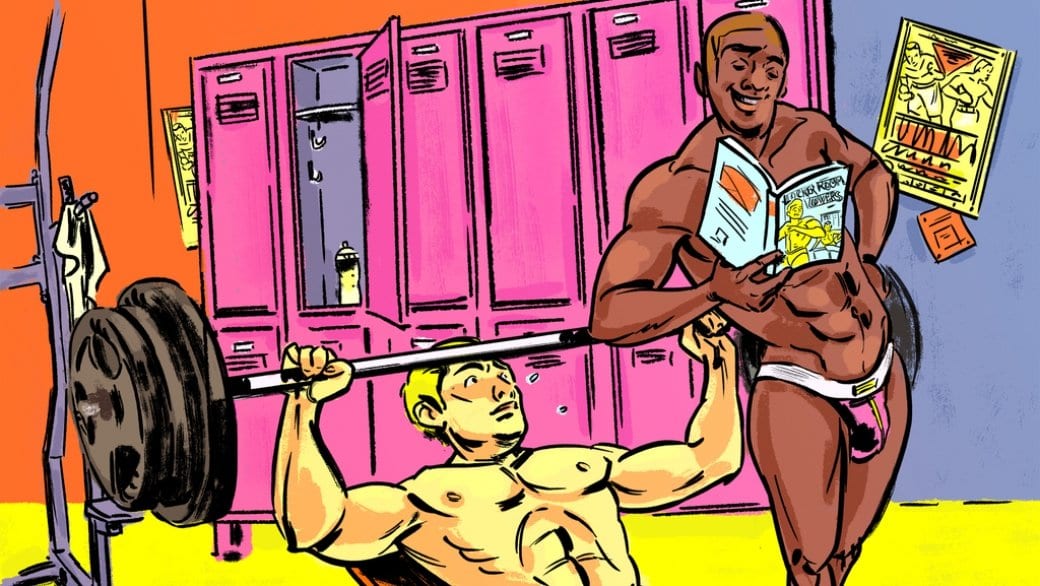Beginning in the late 1940s, books with gay subject matter (and often suggestive titles and cover art) sauntered for the first time onto the shelves of many drugstores, soda shops, dime stores and other such places across the US. The subject matter of gay pulp books was still taboo, but the books were available to those brave enough to take them from the rack.
Among their more enticing titles are things like Summer in Sodom, Lost on the Twilight Road, Gaydreams, Skid Row Sweetie, Bad Boys, The Gay Rebels, The Price of Pansies, Queen of the Road, Rough Trade, Cycle Sadist and Leather Sucker. Considering some of the covers of gay pulps I’ve seen from the ’60s, ’70s and ’80s, I think it must have taken considerable chutzpah to purchase and read one of those books. I imagine that many of them found their way into dark hiding spots, to be later read surreptitiously and frantically before being thrown away to erase the evidence.
Ian Young describes the rise of the gay pulps in the opening of his 2007 book, Out in Paperback: A Visual History of Gay Pulps.
Trying to narrow down what gay pulps are can be a bit tricky. Gay pulps were mass-market (produced in large quantities), cheap paperbacks with gay subject matter. They were usually pocket-sized. They sometimes had titillating cover art (the covers being the best, and often only, way the publishers had to advertise the books). Like pulp fiction generally, the “pulp” part refers to the low-quality, wood pulp paper the books were usually printed on.
Beyond that, they could be just about anything. They spanned fiction and non-fiction. Nearly any genre could be a gay pulp. Some were reprints of older hard covers, others were tawdry or delightfully silly originals. You could find everything from serious political commentary to reprints of literary fiction like Gore Vidal’s The City and the Pillar (first published, not as a pulp, 1948) to original pornographic novels like Leatherman’s Boy (1983).
Homosexuality has been a taboo subject in some eras more than others. Before the Second World War, the only exposure to the subject that most people in the US and Britain would have had was newspaper articles about court cases and scandals — not very encouraging stuff.
If an author was lucky enough to find a publisher willing to publish his gay book, he’d usually still find himself stymied by bookstores unwilling to sell it and libraries unwilling to stock it.
When the Second World War came along, reading and publishing underwent a significant change.
To supply troops with plentiful much-needed reading material, some publishers started to produce cheap paperbacks by the tens of thousands. By the time the war ended, these mass-market paperbacks were commonplace.
This type of book was often sold outside of traditional bookstores, in places that weren’t quite so fussy about what they sold, so long as they made money. Gay subject matter — which, in part because of the 1948 publication of the first Kinsey Report, was in demand — and this new type of publishing were a match made in heaven.
Gay reading material was widely distributed for the first time, suddenly becoming very accessible in the US and Britain.
Young says that many people’s important first exposure to gay culture would have been through reading gay pulps, or at least seeing their covers. He takes it further, suggesting that the rise of pulps aided in the growth of the homophile movement in the US in the 1950s and ’60s.
With his analysis of cover art, Young studies how books changed decade by decade and relates that to the attitudes of the times. By the late 1990s, gay books were commonplace in the catalogues of big publishers and on the shelves of mainstream bookstores, and the gay pulps petered out almost completely.
What I find most engaging is the experience of those reading the earlier pulps for the first time — trying to put myself in the shoes of somebody in the ’60s or ’70s. Maybe it was the sex that made you pick one up. Maybe it was the politics. Maybe the possibility of a new identity. Maybe it was to feel less alone. And I imagine that it was scary, but very, very worth it.
History Boys appears on Daily Xtra on the first and third Tuesday of every month. You can also follow them on Facebook.
Legacy: January 17, 2017 12:00 amAn earlier version of this story incorrectly said that gay pulps made it to mainstream bookstores. They were typically sold outside of traditional bookstores.


 Why you can trust Xtra
Why you can trust Xtra


